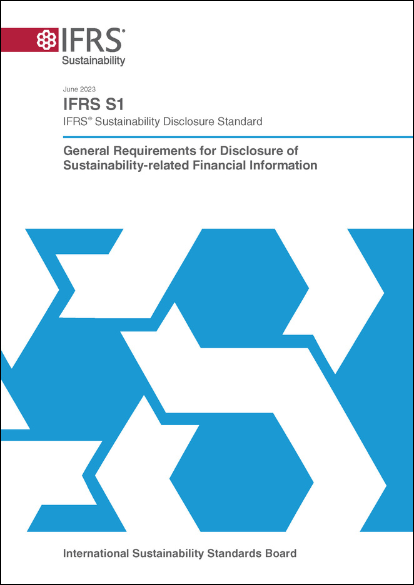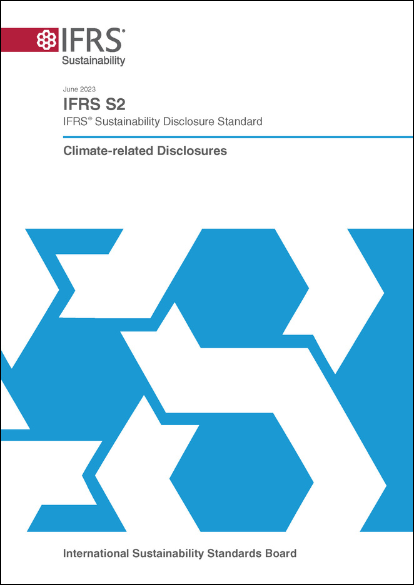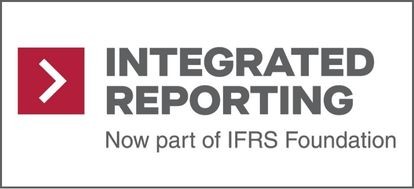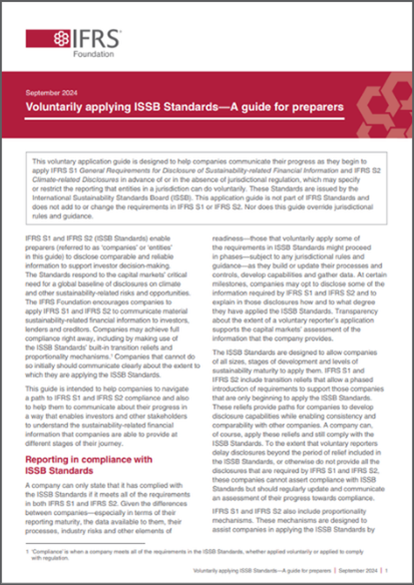The ISSB has led the development of multiple resources linked to the new Standards. This work will continue and the list will be updated as new resources are published.

IFRS S1 General Requirements for Disclosure of Sustainability-related Financial Information
IFRS S1 prescribes how an entity prepares and reports its sustainability-related financial disclosures. It sets out general requirements for the content and presentation of those disclosures so that the information disclosed is useful to users in making decisions relating to providing resources to the entity.
Access IFRS S1 General Requirements for Disclosure of Sustainability-related Financial Information.
Supporting materials for IFRS S1
The ISSB has undertaken a number of activities to support consistent application of the Standard. Find information about all these activities.
Access supporting materials for IFRS S1.

IFRS S2 Climate-related Disclosures
IFRS S2 sets out the requirements for disclosing information about an entity’s climate-related risks and opportunities that could reasonably be expected to affect the entity’s cash flows, its access to finance or cost of capital over the short, medium or long term.
Access IFRS S2 Climate-related Disclosures.
Supporting materials for IFRS S2
The ISSB has undertaken a number of activities to support consistent application of the Standard. Find information about all these activities.
Access supporting materials for IFRS S2.

Introduction to the ISSB Standards
This resource applies a question-and-answer format to:
- provide an overview of the ISSB, its purpose and its role in the global reporting landscape;
- provide an overview of objectives and disclosures prescribed in the IFRS Sustainability Disclosure Standards; and
- summarise how to apply the IFRS Sustainability Disclosure Standards to disclose decision-useful information.

Making the transition from TCFD to ISSB
This resource discusses what taking over monitoring from the TCFD means and how preparers can make the transition over to IFRS Sustainability Disclosure Standards from the TCFD.

Interoperability considerations for GHG emissions when applying GRI Standards and ISSB Standards
This resource has been developed to illustrate the areas of interoperability between GRI 305: Emissions 2016 (GRI 305) and IFRS S2 Climate-related Disclosures (IFRS S2) that a company should consider when measuring and disclosing Scope 1, Scope 2 and Scope 3 greenhouse gas (GHG) emissions in accordance with both Standards.
Read Interoperability considerations for GHG emissions when applying GRI Standards and ISSB Standards.

Integrated reporting frequently asked questions
These integrated reporting FAQs provide practical insights about the fundamental concepts, guiding principles and content elements of the Integrated Reporting Framework, as well as the relationship between the Framework and the IFRS Sustainability Disclosure Standards and other tools in the corporate reporting ecosystem.
Read the integrated reporting frequently asked questions.
How to apply the Integrated Reporting Framework with IFRS S1 and IFRS S2: a mapping tool
This interactive tool aims to show preparers one possible way to incorporate IFRS S1 and IFRS S2 disclosures within an integrated report.
Access the mapping tool.
Transition to integrated reporting: A guide to getting started
This Guide provides a phased approach for implementing the Integrated Reporting Framework and helps preparers understand how IFRS Sustainability Disclosures can be taken into account in their reporting journey.
Access the Guide.

Voluntarily applying ISSB Standards—A guide for preparers
This resource is a comprehensive guide designed to assist preparers to apply ISSB Standards even in the absence of jurisdictional requirements.
Read Voluntarily applying ISSB Standards—A guide for preparers.

